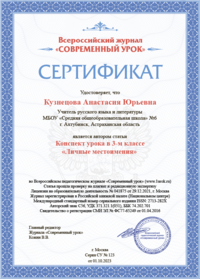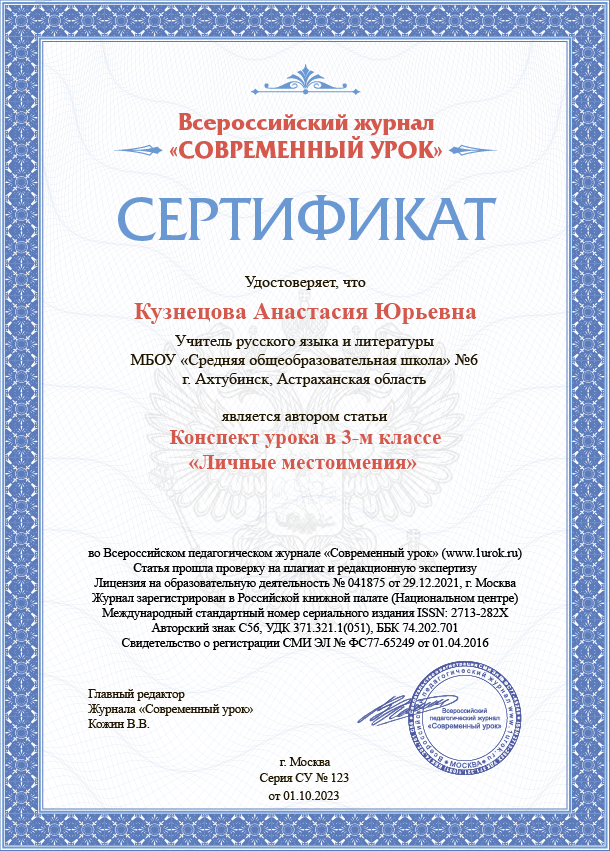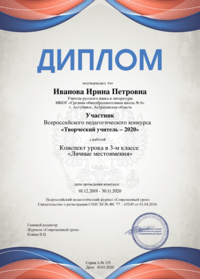Урок: Spread the Word
Автор: Кобзева Наталья Александровна
Организация: ГБОУ СОШ №98
Населенный пункт: г.Санкт-Петербург
Урок “Spread the word”
Урок предназначен для учащихся 9 классов.
Цель урока – формирование креативного мышления.
Задачи урока – знакомство с редкими видами животных, анализ информации, выдвижение разнообразных реалистичных идей.
|
Этапы урока |
Деятельность учителя |
Деятельность учащихся |
Комментарии
|
|
1 Введение темы. |
Учитель с учащимися определяет тему урока, цель и задачи. Учитель предлагает учащимся посмотреть на две картинки с изображениями двух животных и просит сказать, что общего у этих животных. - What do the animals have in common?1 - What are we going to talk about today?2 - What for are we going to talk about them3 - Is there anything we can do for them? - How can we do that?
|
Дети вступают в диалог с учителем. Учащиеся высказывают все возможные идеи, аргументируя свои предположения. (They are wild animals/ They are endangered animals. 1 -Endangered animals2 - To find ways to help them. 3 - To spread the word, raise awareness) - To give a talk to our classmates)
|
Постановка цели с помощью наглядного образа. Прием – загадка.
|
|
2 Прослушивание интервью об исчезающем виде бабочки. |
Учитель предлагает послушать интервью о бабочке и выбрать верные ответы на вопросы в упражнение. (Focus 3 Focus review 5) После проверки учитель задает вопросы по тексту. - Why is it in danger? - What is the possible solution to the problem according to the speakers? Учитель просит предложить свои идеи решения проблем.
|
Ученики выполняют задание и отвечают на вопросы учителя, объясняя свой выбор. Отвечая на дополнительные вопросы учителя по тексту -The monarch butterfly depends on a plant called milkweed to survive in the USA , the chemicals that farmers use on crops are destroying the milkweed plant. In Mexico, trees which are cut down, are the homes of the monarch
|
Данное задание развивает привычку размышлять, анализировать информацию и делать выводы. |
|
3 Чтение текстов в группе и заполнение таблицу. |
Учитель предлагает учащимся прочитать три текста о редких животных и заполнить профиль. |
Ученики в группах читают тексты. После выполнения этого задания, представитель от каждой группы рассказывает по плану о том животном, о котором он прочитал. |
Задание направлено на формирование читательской грамоты |
|
4 Выдвижение идей. Создание плаката со слоганом. |
Учитель обращается к группам с вопросом. – What can we do to help rare/ endangered animals to survive? Учитель приводит пример ы (Consider what we eat…) Учитель просит учащихся нарисовать плакат и придумать емкий слоган к нему. |
Ученики, работая в группах, придумывают, каким образом люди могут помочь исчезающим животным. После обсуждения каждая группа создает плат и представляет его классу. |
Данное задание стимулирует детей выдвигать реалистичные идеи. Задание также направлено на развитие мира социума и взаимоотношений. |
|
5 Завершающий этап |
Учитель задает вопрос What can you personally do to help endangered animals to survive? |
Ученики отвечают, аргументируя свой ответ. |
|
Spread the word
What do the animals have in common?
1 Listen to a radio interview about monarch butterflies and choose the correct answer, A, B, C or D.
1 What is true about monarch butterflies?
A Most of them live in the United States.
B Many of them stay in Mexico after the winter.
C The species no longer exists in North America.
D They migrate from the US to Mexico in winter.
2 How are the monarch butterfly and the milkweed milkweed - a plant ( молочай)
plant connected?
A The monarch causes damage to the milkweed.
B The milkweed needs the monarch to survive.
-C The milkweed is necessary for young monarch
butterflies.
D The monarch eats milkweed when there is nothing
else.
3 Dr Clarke says that people in Mexico
A can’t help the monarch in any way.
-B should stop destroying the forests.
C shouldn’t use chemicals in agriculture.
D must plant milkweed in their gardens.
4 Dr Clarke mainly talks about
A why monarch butterflies migrate over long
distances.
B the effects of farming on the life of monarch
butterflies.
C why monarch butterflies fly to warmer climates
- D the problems monarch butterflies are facing
2. Answer the questions about the monarch butterfly:
Why is it in danger?
What is the possible solution to the problem according to the speakers?
3 Read the texts about some more endangered species and fill in the missing information about the animal you’ve read about:
1 Name___________________________________________________________
2 Habitat _________________________________________________________
3 Population_______________________________________________________
4 Diet ____________________________________________________________
5 Lifespan in the wild _______________________________________________
6 Main threats _____________________________________________________
7 Suggest the best way(s) to help the animal survive _______________________
4 Introduce the animal to your classmates.
5 Think of a memorable slogan. To raise public awareness suggest the best ways to help endangered animals survive.
- Refuse to purchase items made of parts of animals ( leather belts, fur coats)
- Encourage your government to introduce more severe laws prohibiting hunting
- Consider what we eat
- Donate to animal charities
- Adopt pets from rescue centres
- Help out at animal sanctuaries
- Join online campaigns
- Report people who are cruel to animals
- Make cities more wildlife friendly
- Stop cats
- Never smuggle animals
- Reduce use of fertilizers
Тексты для чтения:
The Giant Panda
Native to the mountain forests of southwest China, the giant panda is one of the most beloved animals in the world. The giant panda typically lives around 20 years in the wild and up to 30 years in captivity. They are recognized by their black and white coats but when they are born, they don’t have any hair.
One the main reasons that panda populations have declined is habitat destruction. As the human population in China continues to grow, pandas’ habitat gets taken over by development, pushing them into smaller and less livable areas. Habitat destruction also leads to food shortages. Pandas feed on several varieties of bamboo that bloom at different times of the year. If one type of bamboo is destroyed by development, it can leave the pandas with nothing to eat during the time it normally blooms, increasing the risk of starvation. They eat bamboo and spend about 16 hours a day feeding.
Unfortunately, there is another threat to their survival. Because of their attractiveness they are still killed for their coats. This is illegal but high prices are paid so poachers are willing to take a risk. It is believed that there are only 2000 pandas left in the world. Due to the fact that pandas reproduce so infrequently, it is very difficult for their population to recover from such a low point.
The Polar Bear
Polar bears are the world’s largest land predators, weighing up to 300-600 kg and measuring up to 3 m tall. On average they live to be about 25 years old. Inhabiting the ice and sea of the Arctic, polar bears are well-equipped for survival in a harsh environment. The polar bear’s coat of fur keeps its temperature at an even 37° C. In addition, polar bears’ paws are especially adapted for walking on the ice and swimming in the sea.
Polar bears rely heavily on sea ice for many activities such as travelling, hunting, resting, mating and, in some areas, maternal dens.
- bears are at the top of the food chain and play an important role in keeping the biological populations in balance. Polar bears mostly eat seals. If they can’t hunt for this food source due to a lack of a sturdy ice platform or pure exhaustion, they will move on to other animals. If polar bears are unable to kill seals, the number of seals will subsequently increase, threatening the population of fish in the region, which is an important food source not only for seals, but also for other Arctic wildlife as well as local human populations.
Due to climate change, the Arctic is heating up twice as fast as anywhere else on the planet as a result the polar bear’s habitat is becoming smaller and smaller. As polar bears rely heavily on ice to survive, this leads to a drastic decrease in the number of the species.
Scientists believe that some time between 2059 and 2078 there will be no sea ice in summer in the Arctic Sea. Bears won’t get enough food in the summer, they won’t be able to feed their young and many bears will die in winter.
There are now between 20.000 and 25000 polar bears in the world. Some scientists predict they will disappear before 2050.
Along with sea ice loss, other potential threats to the species include pollution, resource exploration and habitat change due to development.
The Siberian tiger
In 1947 the Siberian tiger was taken under protection and tiger hunting was fully prohibited. 95% of the Siberian tiger world population inhabits the Russian Far-East, 5% of the population lives in China.
It is recognized by its reddish body covered with narrow black stripes. Tigers use black stripes as disguise. Pattern of every tiger is unique, as fingerprints: you won’t find two tigers with identic pattern. Length of the Siberian tiger body without tail is 160-200 cm; length of its tail about 100 cm. Weight of an adult animal can reach 300 kg. Lifespan of the Siberian tiger is 16-18 years (up to 25 years in captivity).
Tigers are almost always in motion. They search for prey while patrolling their territory. They never leave their territory if there’s enough prey within its boundaries. The Siberian tiger has a tremendous physical strength and greatly developed sense organs. Tigers spend a lot of time hunting. When there’s not enough prey in forests the Siberian tiger can attack cattle and dogs.
Tiger’s diet mainly consists of deer, wild boar and elk. Daily food requirement is 9-10 kg of meat. For a well-being one tiger species requires 50-70 hoofed animals annually.
Reproduction periods and birth giving are not confined to certain season. Nevertheless, the Siberian tigers usually produce offspring in April – June. Cubs spend first years of their lives with their mother. After cubs separate from their mother they continue to live on her territory.
Fewer than 600 Siberian tigers remain in the wild, while several hundred more are kept in Zoos and nature parks worldwide. In the 1930s the number of Siberian tigers dramatically fell due to overhunting. Since then the tiger’s recovery has been slow because of the destruction of its habitat, forest fires, a lack of prey. Poaching poses a huge threat to the survival of this rare animal as well.

 БЕСПЛАТНЫЕ семинары
БЕСПЛАТНЫЕ семинары





